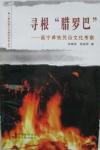
Yang Yaocheng 杨耀程 and Yin Chengjun 殷铖君
Kunming: Yunnan People’s Publishing House, 2011
Reviewed by Zhou Tingsheng (Ph.D. candidate, Minzu University of China, HYI Visiting Fellow 2015-2016)
Co-authored by two native scholars, this book is a highly informative monograph on the folk culture of the Lalo people, a subgroup of Chinese ethnic Yi mainly located in west Yunnan. As indicated in the appendix of the book, the research is based on the authors’ interviews with hundreds of local elders, shamans, artisans, and carpenters, among others, during ten years of fieldwork in the predominantly Lalo Yi townships of Zhujie (珠街乡) and Goujie (耇街乡) in Changning county (昌宁县). This work will especially benefit those who are interested in the indigenous cultures of ethnic minority groups in southwest China.
The book has seven chapters which explore, respectively, the Lalo Yi people’s ethnic origins, cuisine, architecture, costumes, childbirth, marriage, and funeral. Chapter one gives a general introduction to the Lalo Yi people. Chapters two to seven are the main body of this book. Chapter two focuses on the native people’s staple food and delicacies prepared with green and organic products; this chapter includes a discussion of the local people’s concept of natural resource preservation, which is reflected in collecting edible plants from mountains, hunting game in forests, and fishing in rivers. Chapter three describes the Lalo Yi people’s carpentry and the rites related to house-building. Chapter four introduces the traditional costume, with special attention to women’s clothes. Chapter five deals with the rituals of birthing and childhood. The next chapter talks about the wedding ceremony. The last chapter elucidates funeral practices. An appendix discusses the preservation of Lalo Yi folk culture. This book contains much genuine, accurate and authentic information about the Lalo Yi people.
This work highlights the value of a research approach that is based on the authors’ real life experience and their observations gained as insiders. The authors describe and interpret Lalo Yi folk culture enacted in everyday life. Specifically, they elaborate the local delicacies and cuisine, document the ceremonious activities on the day of erecting the framework during house-building, illustrate the beautiful ethnic clothes, introduce the celebration for the coming of a newborn, describe the folk songs popular in wedding ceremonies, and explain the shamans’ chants at funerals. All these exist in the context of a native society in which both authors had grown up before going to college. They even rediscover extinct artifacts and customs. For example, on page 86 the authors describe the procedures for making a coat with a kind of locally-produced fireweed; people stopped using this unique cloth sometime in last century, yet the authors were able to discover its erstwhile existence after interviewing elders who still had knowledge of it; and on page 210 the authors probe the custom of the “entrusting marriage” (寄婚 Jihun) popular in the past, and explain its unpopularity in modern times. In sum, these core chapters are impressively rich.
However, in chapter one the ethnic origins of the Lalo Yi are not fully clarified. For the most part the authors cite classic Chinese works that record facts about southwestern minority groups. Such records are usually prejudiced and sometimes misleading. Classic Chinese works were principally written or compiled in conformity with orthodox Confucianism, unfavorable to the “uncivilized” or “barbarian” minority peoples, and later revised, recompiled or even distorted and misinterpreted several times in accordance with the specific political context of later dynasties. Moreover, in past millennia the aboriginal groups in southwest China migrated from place to place and had frequent contact with neighboring groups. Therefore, it is inappropriate to trace a certain modern minority group to any of the peoples in such records. It seems more promising to explore the origins of a minority group primarily with the help of anthropological methods while referring to the related Chinese works.
Overall, this book is of great significance for advancing our knowledge on the culture of the Lalo Yi people. This is all the more important, because there was no previous publication of any monograph on the folk culture of this particular Yi subgroup. In addition, with the increasing influence of globalization and the digital revolution, thousands of minority cultures and languages around the world are endangered and extinguished. Undoubtedly, the Lalo Yi folk culture is not an exception. Thanks to the unremitting efforts of the two native scholars, the publication of this book contributes not only to studies of cultural diversity in southwest China, but also to the preservation of an endangered culture.
